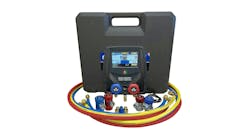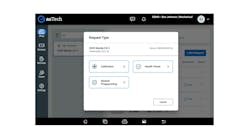The Mac Tools High Performance 1/2” Air Impact Wrench, No. MPF990501, is designed to help technicians perform engine, wheel, crank bolt, steering, suspension and axle bolt removal. This impact wrench offers 1,400 lb-ft of torque and operates up to 6,500 max rpm in forward or reverse, and features a proprietary forged anvil for durability. At 6.4” long, this tool can reach tight areas, and a forward handle design is comfortable to use. Additional features include trigger-activated removable and rechargeable LED lighting, and lightweight magnesium housing.
The review
When working on a vehicle, a good impact wrench is a must-have. Matt Fanslow of Riverside Automotive in Red Wing, Minnesota, found that the tool had plenty of power to handle jobs all day long.
“The gun was used constantly all day, every day, by multiple techs for all steering, suspension work and anything that required wheel removal (brakes, etc.),” Fanslow says. “The impact removed fasteners that some of our other well-known impacts failed to remove.”
Fanslow appreciated that this impact helped save time in the shop.
“The impact hits hard, and the LED lights on the front help immensely in getting on a fastener more quickly,” he says.
This impact wrench required very little setup, Fanslow says. They simply connected the proper adapter to the shop’s air lines and added oil.
“The LEDs were already charged and lasted a couple weeks before we had to charge them,” Fanslow adds.
The tool included a charging cable for the front mounted LEDs and a manual. The LED must be plugged in to activate. Fanslow used the manual before charging the LEDs, but adds that it wasn’t really needed, as operation is quite intuitive.
“I have never seen a group of techs react to the opening of an impact the way my colleagues reacted when I opened the box with this impact,” Fanslow notes. “There were legitimate oohs and aahs.”
Fanslow did find that the flat nose of the tool didn’t have quite as much reach as an impact with a more conical nose, so occasionally he needed to grab an extension to finish the job. However, he doesn’t count this as a design flaw, because the flat nose allows for the LEDs, and he found that the benefit of the LEDs far outweighed the few times an extension was required.
His only suggestion for improvement was trigger responsiveness.
“Too often, it felt like a light squeeze gave a higher output than anticipated or intended,” he says.
While Fanslow has used a variety of impacts, this is the first Mac Tool impact in the shop. “It may not remain that way,” he adds.
Overall, Fanslow appreciated the power and reliability of this impact tool. “This tool does everything asked of it and keeps doing it with multiple users per day,” Fanslow concludes. “What more can
one ask?”




